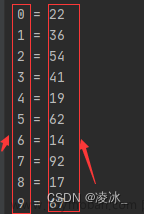「作者主页」:士别三日wyx
「作者简介」:CSDN top100、阿里云博客专家、华为云享专家、网络安全领域优质创作者
「推荐专栏」:小白零基础《Python入门到精通》
insert() 可以把对象「插入」列表的「指定位置」
语法
list.insert( index, obj )
参数
- index :(必选)索引位置
- obj :(可选)需要插入的对象
实例:向列表插入内容
list1 = [1, 2, 3]
list1.insert(1, 'a')
print(list1)
输出:
[1, 'a', 2, 3]
1、插入的位置
设置「索引」来指定对象插入的「位置」,索引有一些特殊的值需要留意。
1.1、正数索引
索引为「正数」时,索引从 0 开始,「从左往右」数。
比如索引为 0 ,就是在左边第一个位置插入;索引为 1,就是在左边第二个位置插入;以此类推
list1 = [1, 2, 3]
list2 = [1, 2, 3]
list1.insert(0, 'a')
print(list1)
list2.insert(1, 'a')
print(list2)
输出:
['a', 1, 2, 3]
[1, 'a', 2, 3]
索引「超过」列表「长度」时,不会报错,而是插入到列表最右边
list1 = [1, 2, 3]
list1.insert(10, 'a')
print(list1)
输出:
[1, 2, 3, 'a']
1.2、负数索引
索引为「负数」时,索引从 0 开始,「从右往左」数。
比如索引为 -1,就是右边第二个位置插入;索引为 -2,就是右边第三个位置插入;依次类推
list1 = [1, 2, 3]
list2 = [1, 2, 3]
list1.insert(-1, 'a')
print(list1)
list2.insert(-2, 'a')
print(list2)
输出:
[1, 2, 'a', 3]
[1, 'a', 2, 3]
索引「超过」列表「长度」时,不会报错,而是插入到列表最左边
list1 = [1, 2, 3]
list1.insert(-10, 'a')
print(list1)
输出:
['a', 1, 2, 3]
这里需要注意下,0 不分正负,负索引的方式,只能从右边第二个位置开始插入,因为已经有 append() 或者 extend() 这种默认添加到列表末尾的函数了。
2、插入对象
insert() 插入的对象可以是「任意类型」。
「整型」和「字符串」类型会当做一个新元素插入
list1 = [1, 2, 3]
list1.insert(1, 'a')
print(list1)
list1.insert(1, 9)
print(list1)
输出:
[1, 'a', 2, 3]
[1, 9, 'a', 2, 3]
「列表」、「元祖」、「字典」这种,不是每一个元素都会插入,而是「整体」作为一个元素插入文章来源:https://www.toymoban.com/news/detail-567437.html
list1 = [1, 2, 3]
list2 = [4, 5]
tuple2 = ('a', 'b')
dict2 = {'key1': 1, 'key2': 2}
str2 = 'abc'
list1.insert(1, list2)
print(list1)
list1.insert(1, tuple2)
print(list1)
list1.insert(1, dict2)
print(list1)
list1.insert(1, str2)
print(list1)
输出:文章来源地址https://www.toymoban.com/news/detail-567437.html
[1, [4, 5], 2, 3]
[1, ('a', 'b'), [4, 5], 2, 3]
[1, {'key1': 1, 'key2': 2}, ('a', 'b'), [4, 5], 2, 3]
[1, 'abc', {'key1': 1, 'key2': 2}, ('a', 'b'), [4, 5], 2, 3]
到了这里,关于Python 列表 insert()函数使用详解的文章就介绍完了。如果您还想了解更多内容,请在右上角搜索TOY模板网以前的文章或继续浏览下面的相关文章,希望大家以后多多支持TOY模板网!












